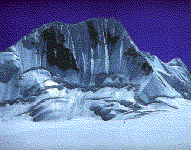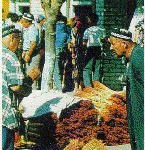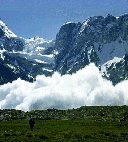


 (In the foto to the right) Unnamed peak in Central Pamir.
The Pamir - "the Roof of the World" - is a large
mountain system extending over the territory of Tadzhikistan and Kirgistan
republics. It has a form of almost quadrangular with about 250 km of each side -
tens of thousands of square kilometers wilh dizzying peaks, snow-capped spires
and towers, ice rivers constantly rent by crevasses, and hanging glaciers. It is
a veritable ocean of white and blue mountains, whichever way you turn. The "roof
of the world" - this is what the Persians called the Pamirs; and although the
highest peaks in the world are in the Himalayas, the Pamirs are slill the main
orographic crux in Asia from which the highest ranges in the world radiate: the
Hindu Kush to the northwest, the Tien Shan system to lhe northeast, the
Karakorum and Himalaya ranges to the southeast. The Pamirs mark the southern
boundary of Central Asia, lhe most fascinating region in the Eurasian continent
and the least developed one from a touristic point of view. Separated from
Russia by the boundless Kazakhstan steppe and surrounded by deserts, Central
Asia was for centuries the crossroads for the trade routes between East and
West. it was here that already in the Ind century B.C. the nomad populations
traced the route that would later be called the Silk Road. Here the legendary
Genghis Khan led his Mongol troops in his devastating invasions of parts of
Europe; here reigned his successor Tamerlane, so famous for his cruelty as well
as for the great works of art created under his rule, such as the monuments in
Samarkand, the capital of his empire. The Russian tsars conquered these regions
only in the early 1800s, but they never succeeded in influencing the local
culture to any extent. Then came the Soviet regime, which attempted to "Russify"
most of the republics of Central Asia -Uzbekistan, Kyrgyzstan, Tadzhikstan,
Kazakhstan, and Turkmenistan. Despite this, much has remained of the peculiar
character of each county and today the cultures, religions and traditions of the
various peoples of Central Asia are passing through a phase of rebirth. The most
famous testament of the rich history of this part of Asia are Samarkand, with
its magical light blue domes; the enchanted fortified oasis of Bukhara, where
Marco Polo stayed; and Khiva, the historic heart of which is a veritable
open-air museum that is still very much alive and all the more precious since
most of the historic towns in this vast region have been destroyed. Then there
are the cities of the Fergana valley still rich in cultural tradition: Margelan,
the ancient city lost in time with its streets populated by Uzbeks with their
typical costumes, old tea houses, open markets with multicoloured fruit; Kokand,
with its great Muslim tradition and the Khan's well preserved, immense palace;
the intriguing Arab city of Osh with its traditional marketplace brimming wilh
perfumed pyramids of fruit and vegetables, dried fruit stalls, pitchers of honey
and fresh cheese, piles of tasty "lavash" flat bread, and the incessant flow of
women with their highly coloured silk dresses worn over the characteristic
trousers and the men in their boots, coats and typical Kyrgyz white felt hats
with black decoration.
(In the foto to the right) Unnamed peak in Central Pamir.
The Pamir - "the Roof of the World" - is a large
mountain system extending over the territory of Tadzhikistan and Kirgistan
republics. It has a form of almost quadrangular with about 250 km of each side -
tens of thousands of square kilometers wilh dizzying peaks, snow-capped spires
and towers, ice rivers constantly rent by crevasses, and hanging glaciers. It is
a veritable ocean of white and blue mountains, whichever way you turn. The "roof
of the world" - this is what the Persians called the Pamirs; and although the
highest peaks in the world are in the Himalayas, the Pamirs are slill the main
orographic crux in Asia from which the highest ranges in the world radiate: the
Hindu Kush to the northwest, the Tien Shan system to lhe northeast, the
Karakorum and Himalaya ranges to the southeast. The Pamirs mark the southern
boundary of Central Asia, lhe most fascinating region in the Eurasian continent
and the least developed one from a touristic point of view. Separated from
Russia by the boundless Kazakhstan steppe and surrounded by deserts, Central
Asia was for centuries the crossroads for the trade routes between East and
West. it was here that already in the Ind century B.C. the nomad populations
traced the route that would later be called the Silk Road. Here the legendary
Genghis Khan led his Mongol troops in his devastating invasions of parts of
Europe; here reigned his successor Tamerlane, so famous for his cruelty as well
as for the great works of art created under his rule, such as the monuments in
Samarkand, the capital of his empire. The Russian tsars conquered these regions
only in the early 1800s, but they never succeeded in influencing the local
culture to any extent. Then came the Soviet regime, which attempted to "Russify"
most of the republics of Central Asia -Uzbekistan, Kyrgyzstan, Tadzhikstan,
Kazakhstan, and Turkmenistan. Despite this, much has remained of the peculiar
character of each county and today the cultures, religions and traditions of the
various peoples of Central Asia are passing through a phase of rebirth. The most
famous testament of the rich history of this part of Asia are Samarkand, with
its magical light blue domes; the enchanted fortified oasis of Bukhara, where
Marco Polo stayed; and Khiva, the historic heart of which is a veritable
open-air museum that is still very much alive and all the more precious since
most of the historic towns in this vast region have been destroyed. Then there
are the cities of the Fergana valley still rich in cultural tradition: Margelan,
the ancient city lost in time with its streets populated by Uzbeks with their
typical costumes, old tea houses, open markets with multicoloured fruit; Kokand,
with its great Muslim tradition and the Khan's well preserved, immense palace;
the intriguing Arab city of Osh with its traditional marketplace brimming wilh
perfumed pyramids of fruit and vegetables, dried fruit stalls, pitchers of honey
and fresh cheese, piles of tasty "lavash" flat bread, and the incessant flow of
women with their highly coloured silk dresses worn over the characteristic
trousers and the men in their boots, coats and typical Kyrgyz white felt hats
with black decoration.  Enclosed between the Alai range to the south and east and by the Tien Shan
range to the north, the Fergana valley is the fertile hearl of these large
mountains. When in the 3rd century B.C. the envoys of the Chinese emperor came
to this region to see the celebrated Fergana horses, whose speed was legendary
throughout Asia, and to seek allies in order to control the trade routes, the
valley had already been intensely cultivated and its towns were the most
frequented oasis in the entire Silk Road. The thriving trade along the ancient
Silk Road, as well as the many invasions on the part of foreign armies that came
to the steppe for booty, developed the complex culture of Central AM. The most
ancient inhabitants of this area descended from immigrants who had fled from
Persia long before Alexander the Great's time; they remained different from lhe
other populations both in their language (which was linked to ancient Persian)
and their work, which was traditionally agricultural. The Turkmens, Uzbeks,
Kazakhs and Kyrgyz, who are of Mongolian stock, arrived later in the successive
waves of immigration or conquest, for centuries they concentrated on horse and
sheep breeding.
During the summer the shepherds slowly take their animals through the
steppes towards the mountains. The Kyrgyz stop at the slopes of the Alai
mountains, where they also train hunting falcons, or they move on to the slopes
of the Pamirs and set up the traditional Central Asian tents, the yurts, which
have been the dwellings of all the nomadic shepherds in this region for
centuries. They are shaped like a wide cylinder with a low cone on top and are
made of curved willow branches covered with thick felt. inside, the "furniture"
consists of a stove, a low table, many rugs and lots of embroidered cloth used
to sleep and sit on, and to keep out the cold. The local shepherds were probably
the guides for the first explorers of the Pamir range, when in the last century
Great Britain and Russia, whose expanding, empires were approaching each other,
decided to initiate a systematic study of the region in order to find the source
of the Indus and Oxas (Amu Darya) rivers. Centuries before, Marco Polo had left
the first description of the Pamirs; he had crossed them in the zone of
present-day Afghanistan during, his legendary journey to Cathay, and among,
other things he mentions the race of huge sheep that were later named after him.
Enclosed between the Alai range to the south and east and by the Tien Shan
range to the north, the Fergana valley is the fertile hearl of these large
mountains. When in the 3rd century B.C. the envoys of the Chinese emperor came
to this region to see the celebrated Fergana horses, whose speed was legendary
throughout Asia, and to seek allies in order to control the trade routes, the
valley had already been intensely cultivated and its towns were the most
frequented oasis in the entire Silk Road. The thriving trade along the ancient
Silk Road, as well as the many invasions on the part of foreign armies that came
to the steppe for booty, developed the complex culture of Central AM. The most
ancient inhabitants of this area descended from immigrants who had fled from
Persia long before Alexander the Great's time; they remained different from lhe
other populations both in their language (which was linked to ancient Persian)
and their work, which was traditionally agricultural. The Turkmens, Uzbeks,
Kazakhs and Kyrgyz, who are of Mongolian stock, arrived later in the successive
waves of immigration or conquest, for centuries they concentrated on horse and
sheep breeding.
During the summer the shepherds slowly take their animals through the
steppes towards the mountains. The Kyrgyz stop at the slopes of the Alai
mountains, where they also train hunting falcons, or they move on to the slopes
of the Pamirs and set up the traditional Central Asian tents, the yurts, which
have been the dwellings of all the nomadic shepherds in this region for
centuries. They are shaped like a wide cylinder with a low cone on top and are
made of curved willow branches covered with thick felt. inside, the "furniture"
consists of a stove, a low table, many rugs and lots of embroidered cloth used
to sleep and sit on, and to keep out the cold. The local shepherds were probably
the guides for the first explorers of the Pamir range, when in the last century
Great Britain and Russia, whose expanding, empires were approaching each other,
decided to initiate a systematic study of the region in order to find the source
of the Indus and Oxas (Amu Darya) rivers. Centuries before, Marco Polo had left
the first description of the Pamirs; he had crossed them in the zone of
present-day Afghanistan during, his legendary journey to Cathay, and among,
other things he mentions the race of huge sheep that were later named after him.
 In 1866 the first Russian expedition arrived in Pamir, led by the naturalist
and explorer fedchenko, who explored the Zaalaiyskiy Mts.and discovered the
immense glacier named after him that until recently was considered the largest
in the world. Other Russian, English and Swedish expeditions followed. Towards
the end of the last century the white zones on the maps of Central Asia
gradually disappeared as more and more geographic and topographic information
was furnished. But Pamir is still a wild region with many unknown and
unconquered valleys and peaks.
The Pamir is basically composed of Zaalaiysliy range with Lenin (7134 m)
peak, Central part with Communism (7495 m) peak dominating - the most high point
and Revolution (6974 m) peak part, and finally south-western Pamir with Engels
(6510 m) and Marx rock towers grandeur.
In 1866 the first Russian expedition arrived in Pamir, led by the naturalist
and explorer fedchenko, who explored the Zaalaiyskiy Mts.and discovered the
immense glacier named after him that until recently was considered the largest
in the world. Other Russian, English and Swedish expeditions followed. Towards
the end of the last century the white zones on the maps of Central Asia
gradually disappeared as more and more geographic and topographic information
was furnished. But Pamir is still a wild region with many unknown and
unconquered valleys and peaks.
The Pamir is basically composed of Zaalaiysliy range with Lenin (7134 m)
peak, Central part with Communism (7495 m) peak dominating - the most high point
and Revolution (6974 m) peak part, and finally south-western Pamir with Engels
(6510 m) and Marx rock towers grandeur.

To be continued...





 Lenin (7134 m) peak
region
Lenin (7134 m) peak
region
 Communism (7495 m) -
Korjenevskoy (7105 m) peaks region
Communism (7495 m) -
Korjenevskoy (7105 m) peaks region
 Revolution (6974 m) peak
region
Revolution (6974 m) peak
region
 South-Western Pamir
region
South-Western Pamir
region